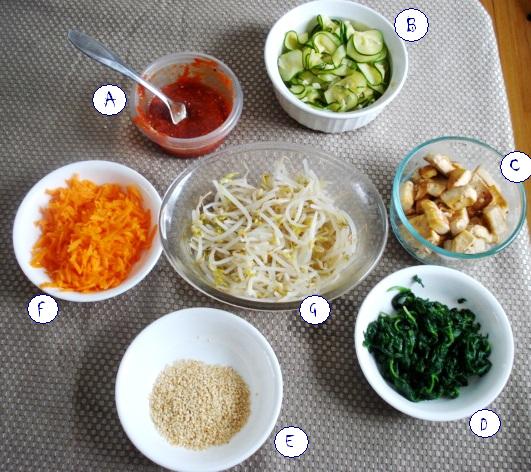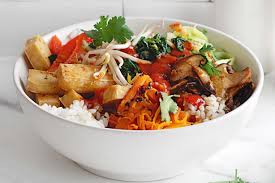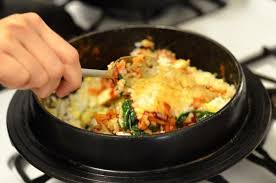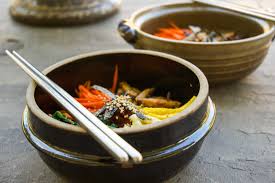If you have heard about Korean Food, I am sure you would be familiar with the name ‘Bibimbap’. This popular signature Korean dish can modestly boast being a pioneer in fueling the recent rage of Korean cuisine and recipes along with its buddies- barbecued Korean bulgogi and samgyeopsal recipes.
Over the past three years of my stay in Seoul, I have enjoyed bibimbap infinite times and would promptly label bibimbap as ‘a no nonsense comfort food’ that you can relish any time of the year. Bibimbap is traditionally prepared with marinated ground beef and topped with raw egg but the recipe I have chosen here is meatless and contains an array of colorful vegetables such as carrots, zucchini, shitake mushrooms and spinach, and soybean sprouts, dried seaweed and soft tofu. The home cooked version of vegetable bibimbap is a clear winner when it comes to low fat and nutrient packed ethnic dishes. The rice is steamed and the vegetables are sautéed in a dash of heart friendly, antioxidant laden sesame oil. The bean sprouts and tofu impart the healthy proteins to this recipe, making bibimbaap a complete, balanced meal having approximately 350 calories per serving.
If you don’t stay in my part of the world, then walking to a nearby ‘hanshik’ (‘han’ refers to Korean and ‘shik’ is food in Korean lingo) restaurant to enjoy the sumptuous bowl of bibimbap might not be a plausible route to this healthy and delicious ‘mixed’ rice dish. But that should not deprive you from the pleasures of digging into this Korean favorite bibimbap. So here is the step by step procedure to prepare bibimbap at home.
The perky red chili paste or ‘gochujang’ used in the recipe can be bought either in glass jars or plastic containers at any Korean or Asian grocery stores. Bibimbap can be served in a shallow, medium sized bowl or in hot stone bowls (if you are using stone bowls, then heat the stone bowl on stove, pour little oil at the bottom and then put the rice and vegetables on the top – rice continues to cook and becomes crunchy). To enjoy bibimbap, plonk in the gochujang (as per desired spiciness) on the top and give the entire dish a hearty mix with a spoon. Now you are ready to eat!
Serves: 2 hearty portions or 4 regular portions
You will Need:
- 1/2 zucchini, julienned
- ½ cup Shiitake Mushrooms
- ½ cup tofu
- 1 large carrot, julienned
- 1 cup soybean sprouts
- 2 cups spinach leaves
- 2 tbsp Toasted sesame seeds

- 4 cups cooked brown or wild rice
- 2 tbsp Sesame oil
- 1 tbsp Rice Vinegar
- 1/2 sheet roasted seaweed (preferably Korean-style kim, but Japanese nori also works), cut into small strips with scissors
- Gochujang (red pepper paste)
- 1 tsp salt ( as per taste)
Method:
Zuchinni or cucumber: Sprinkle zucchini with salt and leave to drain in a colander for 20 minutes. Squeeze out excess water.
Tofu: Rinse and drain tofu. Cut into 1/2-inch thick slices or cubes and place between clean kitchen towels (or paper towels). Heat a tablespoon of sesame oil in a pan and fry tofu, turning once, until golden. Remove tofu from pan. When cool enough to handle, cut into strips.
Carrots: In the same pan, add a tsp of sesame oil and add carrots and a pinch of salt. Stir fry until cooked through. Remove from pan.
Soybean Sprouts and Mushrooms: Blanch in a pot of salted boiling water, just until wilted. Plunge into ice water to stop cooking, then drain and squeeze out excess water. Mix in a small bowl with a pinch of salt, and a dash of sesame seeds. Repeat the same for thinly sliced mushrooms.
Spinach: Blanch in the same pot of salted boiling water, just until wilted and bright green. Plunge into ice water to stop cooking, then drain and squeeze out excess water. Keep aside.
To assemble:
Place the stone bowl or dolsot or 10-inch cast iron skillet over medium heat. When it’s good and hot, add a tablespoon of sesame oil and swirl to coat. Add the rice and pack it down evenly; it should sizzle at the bottom. If you are using regular bowls, then simply place a heap of cooked rice at the center of each serving bowl. Arrange the precooked zucchini, tofu strips or cubes, carrot, soybean sprouts, and spinach around the rice. Drizzle in the remaining sesame oil. If using dolsot, then let the dish cook for a few minutes until ingredients are heated through. Garnish with sesame seeds and seaweed. Keep the gochujang on the table and let the diners add it at the top of the bowl in desired quantity. Mix well and dig in!
Cooking tip:
Instead of arranging the rice and veggies in separate bowls individually, you may skip the assembly part. Mix all the ingredients together in a pan on stove along with the red chilli paste, rice vinegar and sea weed, cook for a while and then serve bibimbap in individual portions garnished with toasted sesame seeds.
Adapted from Vegetable Bibimbap Dolsot Recipe@kitchn.com



